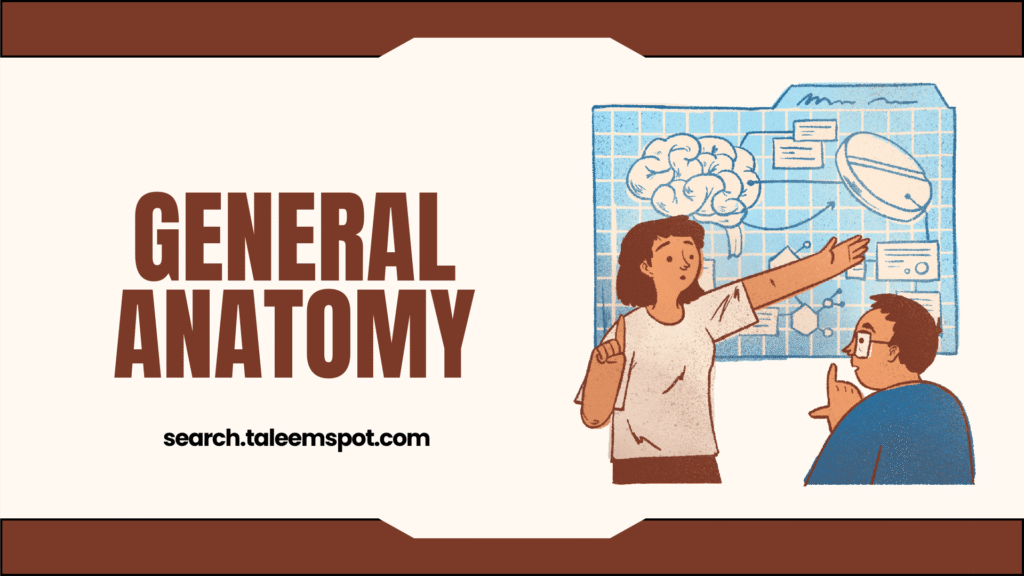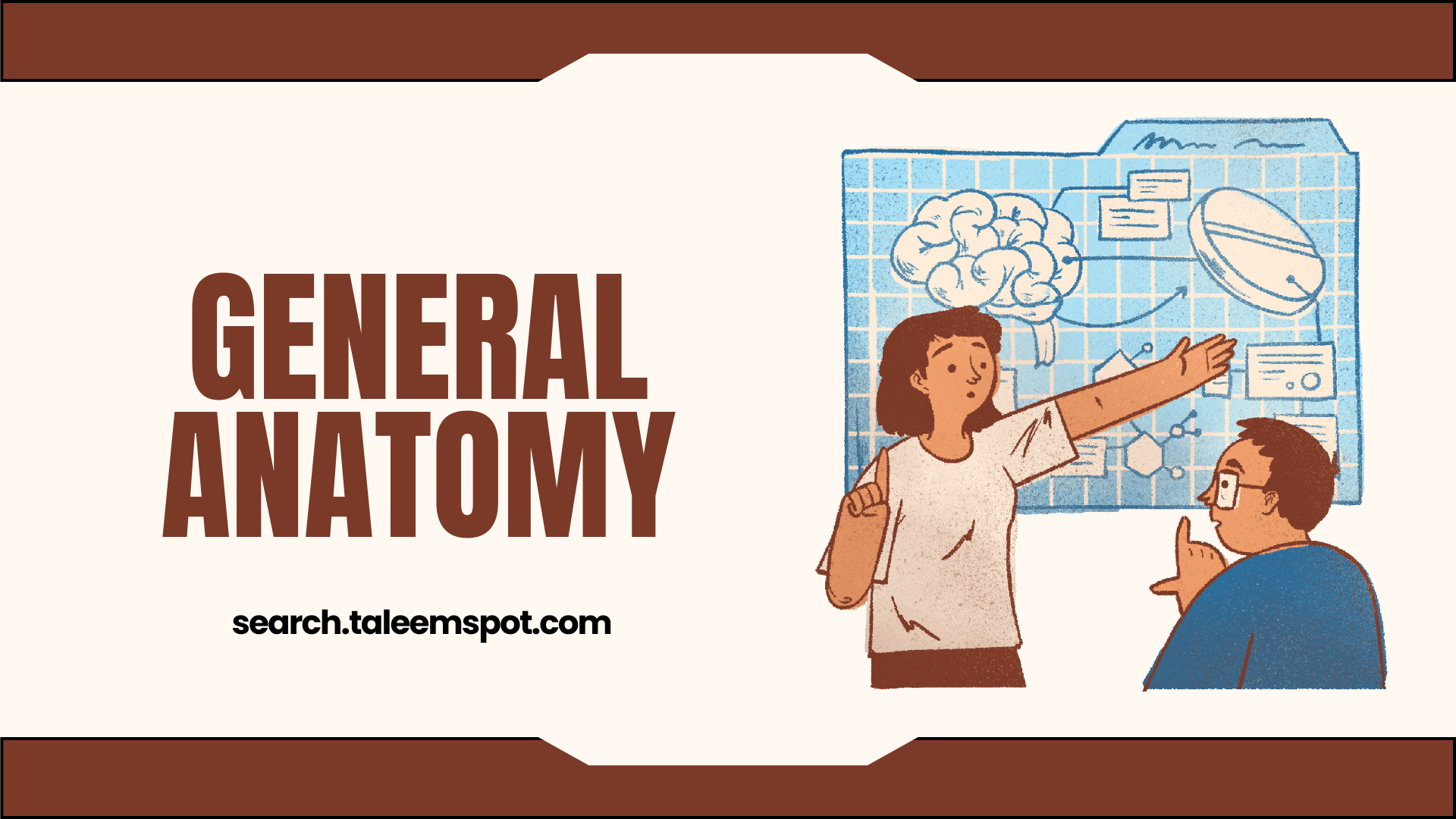Introduction
Anatomy is the scientific study of the structure of living organisms. In humans, general anatomy—also known as systemic anatomy—refers to the foundational knowledge of how the human body is organized into systems, organs, tissues, and cells. It is one of the cornerstones of medical science, forming the basis for understanding how the body functions, how it is affected by disease, and how medical interventions can be applied effectively.
Understanding general anatomy is crucial not only for medical professionals but also for students, researchers, and anyone interested in health and biology. This article delves into the basics of human anatomy, exploring major body systems, structural organization, anatomical terminology, and its clinical relevance.
Structural Organization of the Human Body
The human body exhibits a hierarchical organization, moving from the simplest to the most complex levels:
1. Chemical Level
This level includes atoms and molecules essential for life. Molecules like DNA, proteins, carbohydrates, and lipids form the building blocks of cells.
2. Cellular Level
Cells are the smallest units of life. Different types of cells perform specific functions—muscle cells contract, nerve cells transmit impulses, and epithelial cells form protective layers.
3. Tissue Level
Tissues are groups of similar cells performing a common function. There are four basic tissue types:
- Epithelial Tissue – covers body surfaces and lines cavities.
- Connective Tissue – supports and protects organs.
- Muscle Tissue – enables movement.
- Nervous Tissue – transmits electrical impulses.
4. Organ Level
Organs are composed of two or more tissue types working together. Examples include the heart, lungs, liver, and brain.
5. Organ System Level
Organ systems consist of related organs that work in concert to perform major body functions. There are 11 major organ systems in the human body.
6. Organism Level
The highest level, representing the complete human being functioning as a whole.
Anatomical Terminology
To describe the body accurately, especially in medical and scientific contexts, standardized anatomical terms are used:
- Anatomical Position: The body is upright, facing forward, arms at the sides with palms facing forward, and feet flat.
- Planes of the Body:
- Sagittal Plane: divides the body into left and right sections.
- Frontal (Coronal) Plane: divides the body into front and back.
- Transverse (Horizontal) Plane: divides the body into top and bottom.
- Directional Terms:
- Anterior (ventral) / Posterior (dorsal): front / back
- Superior / Inferior: above / below
- Medial / Lateral: toward the midline / away from the midline
- Proximal / Distal: closer to / farther from the origin of a structure

Major Organ Systems of the Human Body
1. Integumentary System
- Components: Skin, hair, nails, glands.
- Functions: Protects against environmental hazards, regulates body temperature, and provides sensory information.
2. Skeletal System
- Components: Bones, cartilage, ligaments.
- Functions: Supports the body, facilitates movement, protects organs, produces blood cells, and stores minerals.
3. Muscular System
- Components: Skeletal, smooth, and cardiac muscles.
- Functions: Enables movement, maintains posture, and produces heat.
4. Nervous System
- Components: Brain, spinal cord, nerves.
- Functions: Directs immediate responses to stimuli, coordinates activities of other organ systems, and processes sensory information.
5. Endocrine System
- Components: Glands such as the pituitary, thyroid, adrenal, and pancreas.
- Functions: Produces hormones that regulate growth, metabolism, and reproductive processes.
6. Cardiovascular System
- Components: Heart, blood, blood vessels.
- Functions: Distributes oxygen, nutrients, and hormones; removes waste products; helps regulate body temperature.
7. Lymphatic System
- Components: Lymph nodes, lymph vessels, thymus, spleen.
- Functions: Defends against infection and disease; returns fluids to the bloodstream.
8. Respiratory System
- Components: Nose, pharynx, larynx, trachea, bronchi, lungs.
- Functions: Provides oxygen to the bloodstream and removes carbon dioxide.
9. Digestive System
- Components: Mouth, esophagus, stomach, intestines, liver, pancreas.
- Functions: Breaks down food, absorbs nutrients, and eliminates waste.
10. Urinary System
- Components: Kidneys, ureters, bladder, urethra.
- Functions: Eliminates waste products and regulates water, electrolytes, and pH balance.
11. Reproductive System
- Components:
- Male: Testes, penis, prostate.
- Female: Ovaries, uterus, vagina.
- Functions: Produces sex cells and hormones, supports embryonic development (in females).
Body Cavities and Membranes
The body is divided into several cavities that house internal organs:
- Dorsal Cavity: Contains the brain and spinal cord.
- Ventral Cavity: Subdivided into:
- Thoracic Cavity (lungs and heart)
- Abdominopelvic Cavity (digestive organs, bladder, reproductive organs)
Serous membranes (pleura, pericardium, peritoneum) line these cavities and reduce friction between organs.
Clinical Relevance of Anatomy
Understanding anatomy is essential in many medical and health professions for the following reasons:
- Diagnosis: Knowing the location and relationship of organs helps identify sources of symptoms.
- Surgery: Precision in anatomical knowledge prevents accidental injury to nearby structures.
- Radiology: Interpreting imaging studies requires an understanding of normal and pathological anatomy.
- Emergency Care: Immediate interventions, such as CPR or trauma care, depend on anatomical landmarks.
Anatomy in Medical Education and Research
General anatomy is one of the first subjects taught in medical school. It lays the groundwork for:
- Physiology: Understanding how body structures function.
- Pathology: Learning how disease alters normal anatomy.
- Pharmacology: Understanding how drugs interact with body systems.
- Surgical Training: Using cadavers, 3D models, and virtual dissection to teach anatomy practically.
Recent advancements like medical imaging, 3D printing, and virtual reality have revolutionized how anatomy is studied and applied in clinical settings.
Conclusion
General anatomy is not just about memorizing body parts—it’s about understanding the intricate and elegant design of the human body. It connects every other discipline in medicine and is vital to safe, effective healthcare. Whether examining the microscopic level of a single cell or the macroscopic view of an organ system, anatomy provides the blueprint for life and health.
By mastering the principles of general anatomy, one gains insight into the complex orchestration that keeps the human body functioning and the knowledge necessary to diagnose, treat, and care for it when that harmony is disrupted.


